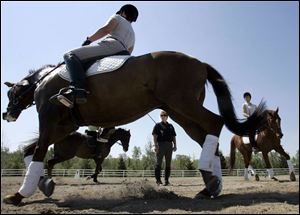
Ballet on horseback challenges rider
5/12/2006
Dressage instructor Janet Harms watches riders Mandy Smith, front; Kate Marci, rear left, and Kim Sullivan putting their horses through drills in preparation for competition.
FINDLAY - Mandy Smith is excited and nervous about riding this weekend in the University of Findlay's first Dressage Show Series.
"I need more experience in the ring. I still get nervous when I show. I tend to hold my breath and that's not good," Ms. Smith said. A veteran rider, but fairly new to dressage, she will have a chance to test her skills on a horse against other university and community equestrians.
About 35 horses will compete at 11:30 a.m. tomorrow at the university's James L. Childs Equestrian Center. The spring-summer series is a great time for the university to sponsor events open to the public, said Janet Harms, dressage instructor at the university.
"It drums up community support and gets the youth more interested in what goes on here," Ms. Harms said.
Greek to many who don't know dressage - a French word that rhymes with massage and means training of the horse - it's referred to as ballet on horseback.
"In dressage, the rider is supposed to communicate flawlessly and seamlessly with the horse so that it produces an image of harmony and fluidity," said Ms. Smith, who graduated from the university last week with a bachelor's degree in business management that included classes in English riding and training with a dressage emphasis.
After graduation, "you can make a career out of showing and competing," Ms. Harms said. Aside from that, graduates can go on to training horses, managing facilities, working with equestrian products, or working in tack shops.
Dressage is a steadily growing sport, said Cindy Vimont, senior director of member services for the United States Dressage Federation.
"I think a lot of people are realizing dressage is the basic of all riding disciplines," she said. Nationally and internationally, riders are beginning to focus more on dressage techniques when training for competition in other disciplines.
Another bonus of the sport is that any breed of horse can be trained for dressage, Ms. Harms said. At the university, students train on thoroughbreds, quarter horses, and other breeds.
Because it's a low-impact sport, "it keeps a healthy horse going and still performing at a much older age" Ms. Vimont said. It's not uncommon for people to switch as their horse ages to compete in dressage. "It's a more relaxed type of sport than from what some of these other people are coming from such as hunting-jumping."
Dressage also is great exercise for the horse, Ms. Vimont said.
The university is the only institution in the area that offers a program with a dressage emphasis. It houses 90 horses in its English equestrian program. Students, which number 40 this year, choose whether they want to focus on hunting-jumping or dressage when they pursue a two-year or four-year degree in equestrian science, which has been available at the school for the last 14 years. Dressage had been a small part of the program until three years ago.
Ms. Smith started riding at age 7 and tied dressage to her skills when she came to the university. It didn't take long for her to be hooked.
"I love it. It's applicable to every single riding discipline,'' she said.
During the university's three-part series that starts tomorrow - the second competition will be held in June and the final in July - horses will be scored on movements such as basic walk, canter, trot, half-passes, and flying change. The rider with the highest total score from the three competitions will earn a trophy. Ribbons will be awarded to the top six riders.